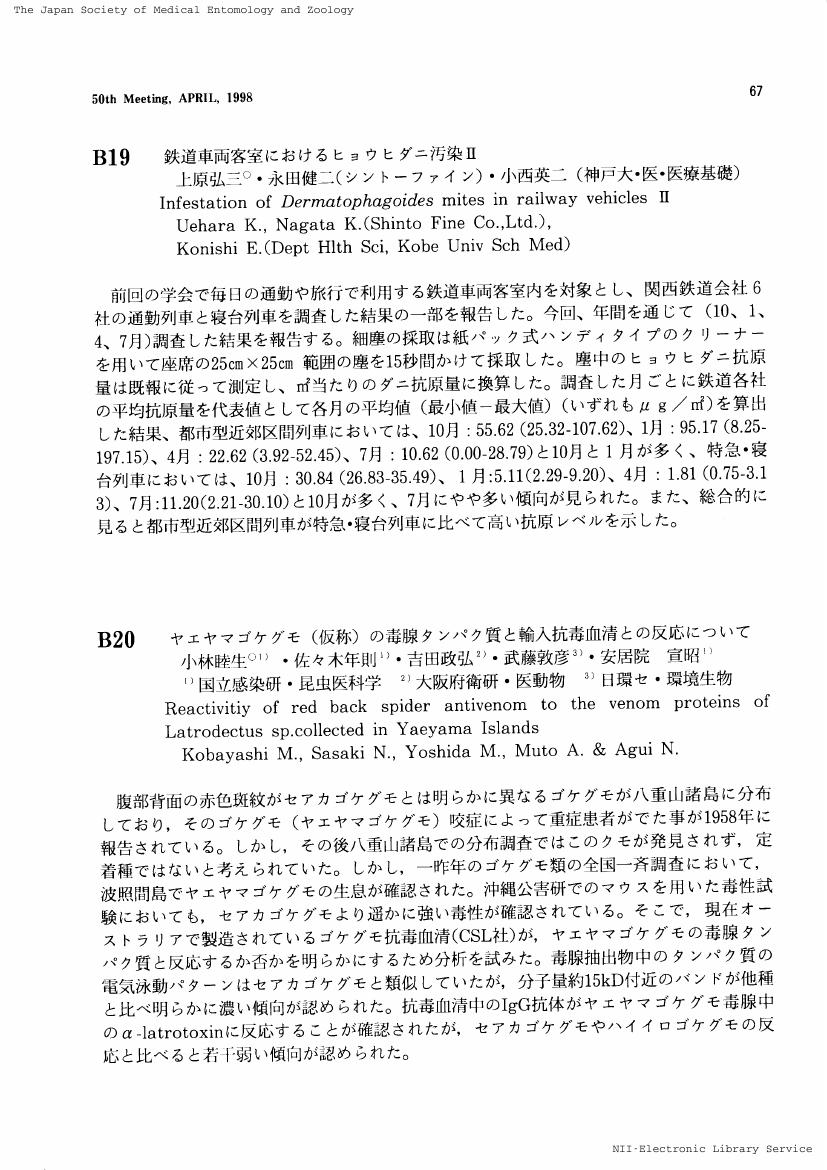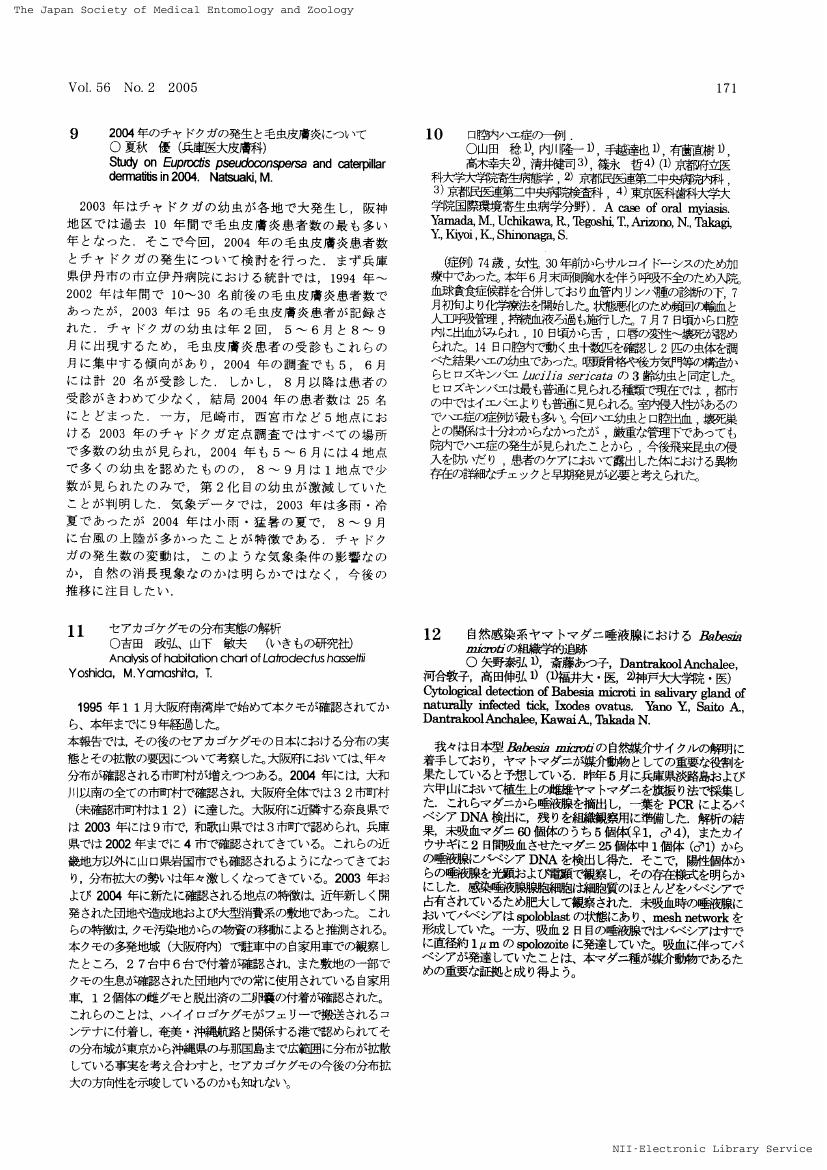1 0 0 0 OA EB16 セアカゴケグモの分布
- 著者
- 吉田 政弘
- 出版者
- 日本衛生動物学会
- 雑誌
- 衛生動物 (ISSN:04247086)
- 巻号頁・発行日
- vol.52, no.Supplement, pp.143, 2001-04-04 (Released:2016-08-09)
- 著者
- 吉田 政弘
- 出版者
- 日本衛生動物学会
- 雑誌
- 衛生動物 (ISSN:04247086)
- 巻号頁・発行日
- vol.59, no.2, pp.114, 2008-06-15 (Released:2016-08-06)
1 0 0 0 OA わが国の有毒蜘蛛, カバキコマチグモ Chiracanthium japonicum Bosenberg et Strand, 1906 の病害と生態に関する研究 : 2. カバキコマチグモの生態
- 著者
- 大利 昌久
- 出版者
- 日本衛生動物学会
- 雑誌
- 衛生動物 (ISSN:04247086)
- 巻号頁・発行日
- vol.27, no.2, pp.181-188, 1976-04-15 (Released:2016-09-05)
- 被引用文献数
- 3 2
Chiracanthium japonicum is well known as a poisonous spider. The geographical distribution of the spider was studied in various localities in Japan during the period from 1959 to 1975. This spider was recognized to distribute widely in Japan. From the study on the vertical distribution at Mt. Kyoga located on the Nagasaki-Saga prefectural border, Kyushu, South Japan, they were found widely over various heights, though they were most abundant in the zone from 200 to 300m in height. Ecological field study was made on the seasonal change and habitats at the mountain of Shironokoshi in Nagasaki Prefecture during the period from March to September in 1967. The total number of 1331 spiders, which consisted of 577 male and 754 female spiders, was recorded from the survey areas. They were distributed mostly in bush, especially in Gramineae groups during the period from May to July. The laboratory observation was made on their behavior, especially on mating, breeding and hatching. Among them, it was the most dramatic behavior that the spiderlings caught and killed their mother after the second molting. The parasitic insect which was observed on the back of this spider was identified as Homonotusiwatai Yasumatsu (Hymenoptera; Pompilidae). The best method for eliminating this species to prevent arachnidism is by means of the weeding of the grass belonging to the family Gramineae at areas close to houses in April before the final molting of male spiders. Children must be taught that this spider is dangerous, because they are more often bitten than adults.
1 0 0 0 OA 各種殺虫剤のセアカゴケグモ Latrodectus hasseltii に対する殺虫効力
- 著者
- 永田 健二 新庄 五朗 奥田 寿男 吉田 政弘
- 出版者
- 日本衛生動物学会
- 雑誌
- 衛生動物 (ISSN:04247086)
- 巻号頁・発行日
- vol.48, no.2, pp.135-139, 1997-06-15 (Released:2016-08-20)
- 参考文献数
- 6
- 被引用文献数
- 1 3
Lethal and knockdown effects of several insecticides to red-back widow spiders, Latrodectus hasseltii, were evaluated. Spiders were collected three times in Osaka and Mie Prefectures, Japan, in 1995 and 1996. In the continuous contact method on glass pot and the topical application method, permethrin and phenothrin were most effective among the tested insecticides. Knockdown and lethal effects by spraying with commercial insecticide aerosols, containing pyrethroids, were sufficient in the case of direct spraying without the web, but the effects decreased in the case of spraying through the web.
1 0 0 0 OA B20 ヤエヤマゴケグモ (仮称) の毒腺タンパク質と輸入抗毒血清との反応について
1 0 0 0 OA 51 セアカゴケグモの分布(2003年)
- 著者
- 吉田 政弘
- 出版者
- 日本衛生動物学会
- 雑誌
- 衛生動物 (ISSN:04247086)
- 巻号頁・発行日
- vol.55, no.Supplement, pp.57, 2004-04-01 (Released:2016-08-07)
1 0 0 0 OA 衛生害虫の天敵としてのクモ類の研究 : 3. オオヒメグモの生態
- 著者
- 大利 昌久
- 出版者
- 日本衛生動物学会
- 雑誌
- 衛生動物 (ISSN:04247086)
- 巻号頁・発行日
- vol.26, no.1, pp.15-19, 1975-05-15 (Released:2016-09-05)
- 被引用文献数
- 2 4
A study was made on the distribution and population density of the spider, Theridion tepidariorum, which is well known as one of the natural enemies of pest insects, in various localities in Nagasaki Prefecture in 1966. The number of T. tepidariorum was observed over eight different kinds of environment : forests, paddy field, farms, caves, sewers, houses (urban and suburban) and cattle barns. Their population density was highest at the inside of animal sheds and houses, in which this spider was found abandantly in the barn, kitchen and latrine. The seasonal prevalene in the house and the breeding season in three stations were also surveyed throughout a year. The peak of the population density in the house was observed in June and July. Many egg-sacs were layed in the warm season from May to August with a marked peak in June and a few in the rest seasons. The mean frequency of oviposition per female in a whole life was 3.08 and the mean number of eggs per egg-sac was 347.1. The preys of this species were insect species belonging to the orders Blattaria, Dermaptera, Isoptera, Hemiptera, Mecoptera, Lepidoptera, Coleoptera, Hymenoptera and Diptera, Among them, many of the flies, chironomids (Diptera) and Blattaria were trapped by the web more frequently than any other insects.
- 著者
- 木船 悌嗣
- 出版者
- 日本衛生動物学会
- 雑誌
- 衛生動物 (ISSN:04247086)
- 巻号頁・発行日
- vol.46, no.1, pp.18, 1995-03-15 (Released:2016-08-23)
- 被引用文献数
- 1
1 0 0 0 OA 衛生動物毒素研究最近の進歩 : クモ、サソリ、ハチ、クラゲ毒など
- 著者
- 中嶋 暉躬
- 出版者
- 日本衛生動物学会
- 雑誌
- 衛生動物 (ISSN:04247086)
- 巻号頁・発行日
- vol.53, no.Supplement, pp.22, 2002-04-01 (Released:2016-08-07)
1 0 0 0 OA 11 セアカゴケグモの分布実態の解析(第59回日本衛生動物学会西日本支部大会講演要旨)
- 著者
- 吉田 政弘 山下 敏夫
- 出版者
- 日本衛生動物学会
- 雑誌
- 衛生動物 (ISSN:04247086)
- 巻号頁・発行日
- vol.56, no.2, pp.171, 2005-06-15 (Released:2016-08-07)
1 0 0 0 OA 2 日本における毒グモの分布と今後の動向(第2回日本衛生動物学会西日本支部例会講演要旨)
- 著者
- 吉田 政弘
- 出版者
- 日本衛生動物学会
- 雑誌
- 衛生動物 (ISSN:04247086)
- 巻号頁・発行日
- vol.59, no.2, pp.129-130, 2008-06-15 (Released:2016-08-06)
- 著者
- 大利 昌久
- 出版者
- 日本衛生動物学会
- 雑誌
- 衛生動物 (ISSN:04247086)
- 巻号頁・発行日
- vol.29, no.4, pp.361-364, 1978-12-15 (Released:2016-09-05)
- 被引用文献数
- 1 1
An epidemiological survey by questionnaire was made on arachnidism caused by the spider, Chiracanthium japonicum, in Japan. Among 42 arachnologists and 79 medical doctors, who are interested in arachnidism, 90 researchers submitted clinical records of bite cases in response to the questionnaire. A total of 28 patients of arachnidism was reported from different prefectures including Hokkaido, Aomori, Fukushima, Iwate, Miyagi, Gumma, Kanagawa, Yamanashi, Aichi, Wakayama, Mie, Nagasaki and Saga. Analysis of these 28 cases was made in which the sex of causative spiders, seasonal frequency, age and sex distribution of patients, location bitten, site of bites, severity and duration of time suffered were examined. From this epidemiological analysis, arachnidism caused by Chiracanthium japonicum was summarized as follows : A) The arachnidism occurred very commonly in Japan during a period of four months from May to August, with a peak in June. B) During the mating season the male spiders searching for mates accidentally infest human hibitats and inflict their bites most commonly during the midnight hour while the humans are sleeping. C) The site of bites was most frequently observed in the upper extremities. D) A drastic difference is observed in arachnidism caused by male versus female spiders. Male spiders produce sharp pain at the bite while the female causes intensive itching. However, both sexes produce redness over the skin lesion.
- 著者
- 大利 昌久
- 出版者
- 日本衛生動物学会
- 雑誌
- 衛生動物 (ISSN:04247086)
- 巻号頁・発行日
- vol.29, no.2, pp.139-145, 1978-06-15 (Released:2016-09-05)
Arachnidism caused by the genus Chiracanthium has been reported from subtropical or warm temperate zones in all over the world. So far in Japan, total 50 cases of arachnidism caused by C. japonicum, which is recognized to be most dangerous, were recorded and analized epidemiologically from the medical points of view up to 1976. The investigation was made on the function and the histology of the venom apparatus for the purpose of analysing the cause of arachnidism. The venom apparatus is associated with the chelicerae or first pair of appendages of the cephalothorax. Each consists of a large basal segment and a terminal claw-like fang piecerced by the duct from the venom gland. The fang of male is about two times longer than that of female, therefore, the fangs of male was found to be able to penetrate the palmar skin of volunteer more deeper than that of female. The muscularis was found to cover the whole gland beginning from the neck of the gland. This is the bundle of fibers of striated-muscle. The basement membrane from a continuous layer under the muscularis. The two kinds of epithelial cells were observed lining the basement membrane. The first layer is formed by small and low cells with an ovarial nucleus. The second layer is formed by high columnar cells attaching on the basement membrane. Both the nuclei of the first and the second cells show the same morphological structure by the optical microscopy.
1 0 0 0 OA 1 群馬県内で発生したカバキコマチグモ咬傷について
1 0 0 0 OA 1 千葉県におけるクモの同定依頼
- 著者
- 角田 隆 藤曲 正登
- 出版者
- 日本衛生動物学会
- 雑誌
- 衛生動物 (ISSN:04247086)
- 巻号頁・発行日
- vol.51, no.2, pp.119, 2000-06-15 (Released:2016-08-09)
1 0 0 0 OA B39 セアカゴケグモの防除について
1 0 0 0 OA 133 日本に上陸したセアカゴケグモについて : (2) 低温下における飼育成績
1 0 0 0 OA B09 日本におけるハイイロゴケグモの分布 (2002)
- 著者
- 吉田 政弘
- 出版者
- 日本衛生動物学会
- 雑誌
- 衛生動物 (ISSN:04247086)
- 巻号頁・発行日
- vol.54, no.supplement, pp.37, 2003-04-01 (Released:2016-08-07)














